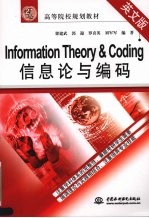

信息论与编码 英文版PDF电子书下载
- 电子书积分:9 积分如何计算积分?
- 作 者:梁建武,郭迎,罗喜英等编著
- 出 版 社:北京:中国水利水电出版社
- 出版年份:2008
- ISBN:9787508455693
- 页数:197 页
Chapter 1 Introduction 1
Contents 1
Before it starts,there is something must be known 1
1.1 What is Information 2
1.2 What's Information Theory? 4
1.2.1 Origin and Development of Information Theory 4
1.2.2 The application and achievement of Information Theory methods 6
1.3 Formation and Development of Information Theory 7
Questions and Exercises 8
Biography of Claude Elwood Shannon 8
Chapter 2 Basic Concepts of Information Theory 11
Contents 11
Preparation knowledge 11
2.1 Self-information and conditional self-information 12
2.1.1 Self-Information 12
2.1.2 Conditional Self-Information 14
2.2 Mutual information and conditional mutual information 14
2.3 Source entropy 16
2.3.1 Introduction of entropy 16
2.3.2 Mathematics description of source entropy 17
2.3.3 Conditional entropy 20
2.3.4 Union entropy(Communal entropy) 20
2.3.5 Basic nature and theorem of source entropy 21
2.4 Average mutual information 26
2.4.1 Definition 26
2.4.2 Physics significance of average mutual information 27
2.4.3 Properties of average mutual information 28
2.5 Continuous source 38
2.5.1 Entropy of the continuous source(also called differential entropy) 39
2.5.2 Mutual information of the continuous random variable 44
Questions and Exercises 44
Additional reading materials 46
Chapter 3 Discrete Source Information 51
Contents 51
3.1 Mathematical model and classification of the source 51
3.2 The discrete source without memory 54
3.3 Multi-marks discrete steady source 60
3.4 Source entropy of discrete steady source and limit entropy 67
3.5 The source redundancy and the information difference 71
3.6 Markov information source 71
Exercise 77
Chapter 4 Channel and Channel Capacity 79
Contents 79
4.1 The model and classification of the channel 79
4.1.1 Channel Models 79
4.1.2 Channel classifications 80
4.2 Channel doubt degree and average mutual information 82
4.2.1 Channel doubt degree 82
4.2.2 Average mutual information 82
4.2.3 Properties of mutual information function 83
4.2.4 Relationship between entropy,channel doubt degree and mutual information 86
4.3 The discrete channel without memory and its channel capacity 88
4.4 Channel capacity 89
4.4.1 Concept of channel capacity 89
4.4.2 Discrete channel without memory and its channel capacity 91
4.4.3 Continuous channel and its channel capacity 99
Chapter 5 Lossless source coding 106
Contents 106
5.1 Lossless coder 106
5.2 Lossless source coding 110
5.2.1 Fixed length coding theorem 110
5.2.2 Unfixed length source coding 113
5.3 Lossless source coding theorems 115
5.3.1 Classification of code and main coding method 115
5.3.2 Kraft theorem 116
5.3.3 Lossless unfixed source coding theorem(Shannon First theorem) 116
5.4 Pragmatic examples of lossless source coding 120
5.4.1 Huffman coding 120
5.4.2 Shannon coding and Fano coding 128
5.5 The Lempel-ziv algorithm 130
5.6 Run-Length Encoding and the PCX format 132
Questions and Exercises 134
Chapter 6 Limited distortion source coding 137
Contents 137
6.1 The start point of limit distortion theory 138
6.2 Distortion measurement 140
6.2.1 Distortion function 140
6.2.2 Average distortion 142
6.3 Information rate distortion function 143
6.4 Property of R(D) 145
6.4.1 Minimum of D and R(D) 145
6.4.2 Dmax and R(Dmax) 151
6.4.3 The under convex function of R(D) 154
6.4.4 The decreasing function of R(D) 154
6.4.5 R(D)is a continuous function of D 155
6.5 Calculation of R(D) 156
6.5.1 Calculation of R(D)of binary symmetric source 156
6.5.2 Calculation of R(D)of Gauss source 158
6.6 Limited distortion source encoding theorem 159
Additional material for this chapter 161
Questions and exercises 168
Chapter 7 Channel Coding Theory 170
Contents 170
7.1 Channel coding theorem for noisy channel 170
7.2 Introduction:the generator and parity-check matrices 174
7.3 Syndrome decoding on q-ary symmetric channels 177
7.4 Hamming geometry and code performance 179
7.5 Hamming codes 180
7.6 Cyclic code 181
7.7 Syndrome decoding on general q-ary channels 191
Questions and exercises 194
Bibliography 197
- 《管理信息系统习题集》郭晓军 2016
- 《信息系统安全技术管理策略 信息安全经济学视角》赵柳榕著 2020
- 《卓有成效的管理者 中英文双语版》(美)彼得·德鲁克许是祥译;那国毅审校 2019
- 《ESG指标管理与信息披露指南》管竹笋,林波,代奕波主编 2019
- 《AutoCAD 2018自学视频教程 标准版 中文版》CAD/CAM/CAE技术联盟 2019
- 《跟孩子一起看图学英文》张紫颖著 2019
- 《大学计算机信息技术教程 2018版》张福炎 2018
- 《大数据环境下的信息管理方法技术与服务创新丛书 俄罗斯档案事业改革与发展研究》徐胡乡责编;肖秋会 2019
- 《AutoCAD机械设计实例精解 2019中文版》北京兆迪科技有限公司编著 2019
- 《交通工程安全风险管控与隐患排查一体化理论方法与信息化管理技术》王海燕著 2019
- 《市政工程基础》杨岚编著 2009
- 《家畜百宝 猪、牛、羊、鸡的综合利用》山西省商业厅组织技术处编著 1959
- 《世说新语校笺 第1册》(南朝宋)刘义庆撰;(南朝梁)刘孝标注;杨勇校笺 2019
- 《《道德经》200句》崇贤书院编著 2018
- 《高级英语阅读与听说教程》刘秀梅编著 2019
- 《计算机网络与通信基础》谢雨飞,田启川编著 2019
- 《看图自学吉他弹唱教程》陈飞编著 2019
- 《法语词汇认知联想记忆法》刘莲编著 2020
- 《培智学校义务教育实验教科书教师教学用书 生活适应 二年级 上》人民教育出版社,课程教材研究所,特殊教育课程教材研究中心编著 2019
- 《国家社科基金项目申报规范 技巧与案例 第3版 2020》文传浩,夏宇编著 2019
- 《中国当代乡土小说文库 本乡本土》(中国)刘玉堂 2019
- 《异质性条件下技术创新最优市场结构研究 以中国高技术产业为例》千慧雄 2019
- 《中国铁路人 第三届现实主义网络文学征文大赛一等奖》恒传录著 2019
- 《莼江曲谱 2 中国昆曲博物馆藏稀见昆剧手抄曲谱汇编之一》郭腊梅主编;孙伊婷副主编;孙文明,孙伊婷编委;中国昆曲博物馆编 2018
- 《中国制造业绿色供应链发展研究报告》中国电子信息产业发展研究院 2019
- 《中央财政支持提升专业服务产业发展能力项目水利工程专业课程建设成果 设施农业工程技术》赵英编 2018
- 《中国陈设艺术史》赵囡囡著 2019
- 《指向核心素养 北京十一学校名师教学设计 英语 七年级 上 配人教版》周志英总主编 2019
- 《《走近科学》精选丛书 中国UFO悬案调查》郭之文 2019
- 《清至民国中国西北戏剧经典唱段汇辑 第8卷》孔令纪 2018
